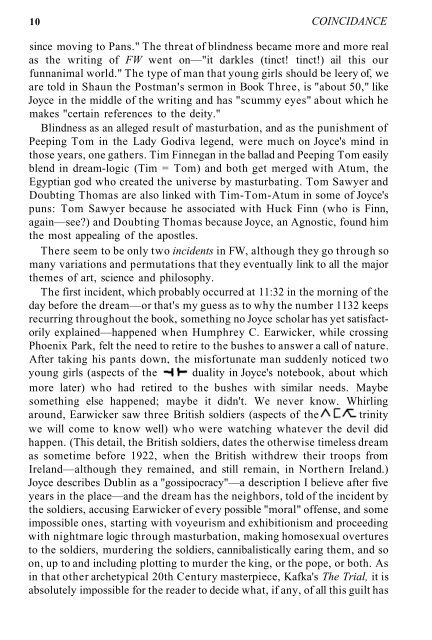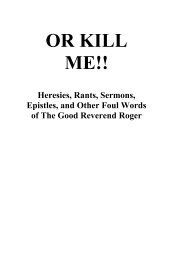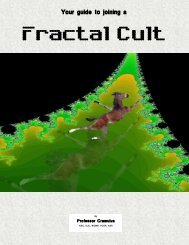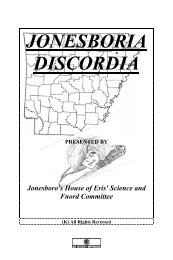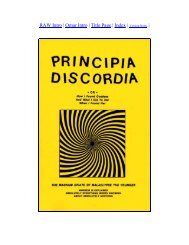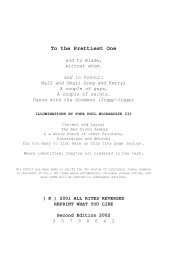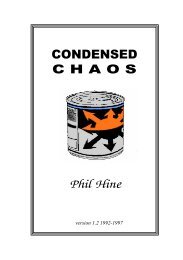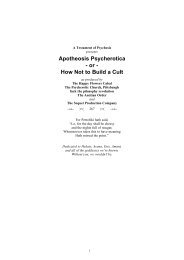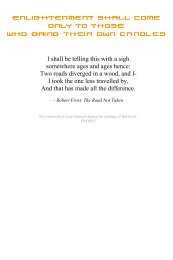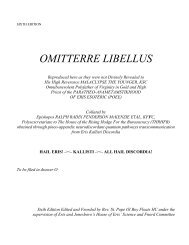Coincidance - Principia Discordia
Coincidance - Principia Discordia
Coincidance - Principia Discordia
Create successful ePaper yourself
Turn your PDF publications into a flip-book with our unique Google optimized e-Paper software.
10 COINCIDANCE<br />
since moving to Pans." The threat of blindness became more and more real<br />
as the writing of FW went on—"it darkles (tinct! tinct!) ail this our<br />
funnanimal world." The type of man that young girls should be leery of, we<br />
are told in Shaun the Postman's sermon in Book Three, is "about 50," like<br />
Joyce in the middle of the writing and has "scummy eyes" about which he<br />
makes "certain references to the deity."<br />
Blindness as an alleged result of masturbation, and as the punishment of<br />
Peeping Tom in the Lady Godiva legend, were much on Joyce's mind in<br />
those years, one gathers. Tim Finnegan in the ballad and Peeping Tom easily<br />
blend in dream-logic (Tim = Tom) and both get merged with Atum, the<br />
Egyptian god who created the universe by masturbating. Tom Sawyer and<br />
Doubting Thomas are also linked with Tim-Tom-Atum in some of Joyce's<br />
puns: Tom Sawyer because he associated with Huck Finn (who is Finn,<br />
again—see?) and Doubting Thomas because Joyce, an Agnostic, found him<br />
the most appealing of the apostles.<br />
There seem to be only two incidents in FW, although they go through so<br />
many variations and permutations that they eventually link to all the major<br />
themes of art, science and philosophy.<br />
The first incident, which probably occurred at 11:32 in the morning of the<br />
day before the dream—or that's my guess as to why the number 1132 keeps<br />
recurring throughout the book, something no Joyce scholar has yet satisfactorily<br />
explained—happened when Humphrey C. Earwicker, while crossing<br />
Phoenix Park, felt the need to retire to the bushes to answer a call of nature.<br />
After taking his pants down, the misfortunate man suddenly noticed two<br />
young girls (aspects of the duality in Joyce's notebook, about which<br />
more later) who had retired to the bushes with similar needs. Maybe<br />
something else happened; maybe it didn't. We never know. Whirling<br />
around, Earwicker saw three British soldiers (aspects of the trinity<br />
we will come to know well) who were watching whatever the devil did<br />
happen. (This detail, the British soldiers, dates the otherwise timeless dream<br />
as sometime before 1922, when the British withdrew their troops from<br />
Ireland—although they remained, and still remain, in Northern Ireland.)<br />
Joyce describes Dublin as a "gossipocracy"—a description I believe after five<br />
years in the place—and the dream has the neighbors, told of the incident by<br />
the soldiers, accusing Earwicker of every possible "moral" offense, and some<br />
impossible ones, starting with voyeurism and exhibitionism and proceeding<br />
with nightmare logic through masturbation, making homosexual overtures<br />
to the soldiers, murdering the soldiers, cannibalistically earing them, and so<br />
on, up to and including plotting to murder the king, or the pope, or both. As<br />
in that other archetypical 20th Century masterpiece, Kafka's The Trial, it is<br />
absolutely impossible for the reader to decide what, if any, of all this guilt has


